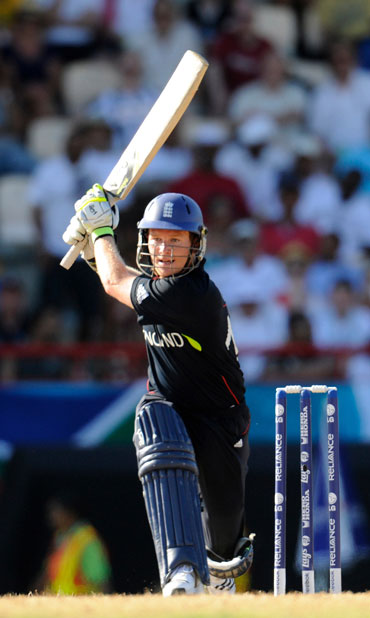 | « Back to article | Print this article |
Twenty20 comes of age in Caribbean feast
Twenty20 cricket came home with England's impressive World Cup win on Sunday and the game, which began as a crowd-pleasing thrash, really came of age over the past three weeks in the Caribbean.
Players continue to push themselves technically and physically to gain every advantage in the compressed format of the game and wild slogging, which many feared was all Twenty20 was, just does not deliver against top quality bowling.
Instead, in a superb breakneck tournament where large crowds of travelling fans and local West Indians were treated to two games a day, there was some outstanding cricket.
"I think if you ask the people watching on television or at the games, they will say it has been a wonderful spectacle and I think it is here to stay now," Australia captain Michael Clarke said.
Hussey's innings will be remembered for a long time
The innings that will be remembered longest will be Australian Michael Hussey's 60 from 24 balls, including six sixes and three in the last over, which inspired an astonishing comeback win over Pakistan in the semi-finals.
Hussey's boundaries were struck with brilliant timing on a big ground in St Lucia and he also showed the way athletic players can pick up two runs with intelligent placement and smart running between the wickets.
Hussey, like his team-mate Cameron White and England's Eoin Morgan, showed the value of a batsman down the order who can increase the tempo and take his side from a decent score to a winning one.
There were also examples of classical opening batting which, while full of the aggressive intent needed in the shortest form of the game, would not have been out of place in a Test match.
Classic stroke makers have a role in T20s
Sri Lankan Mahela Jayawardene's century against Zimbabwe and his outstanding 98 against West Indies were reminders that big scores can be made with classic strokes combined with intelligent strategy.
West Indies captain Chris Gayle's 98 against India contained plenty of his trademark powerful smashes but was only possible through patience and clever reading of the bowling.
For most batsmen, though, with limited time at the crease and little opportunity to get settled, the game is about maximising every delivery and watching England train was enlightening.
Batsmen undergo 'stand and swing' sessions on the middle of the field in which they smash full tosses into the stands, gauging their range and getting used to the force needed to clear the ropes.
Detailed Thought
There was also much detailed thought into the approach needed against specific bowlers.
Morgan could be heard in deep conversation with fellow left-hander Michael Lumb about the best bat angles to use against Australia's left-armers because Twenty20 batsmen need to ensure that a defensive stroke brings at least a single.
The bowlers go through the same level of analysis and improvisation, working hard in the nets on slower balls and ensuring they have a variety of deliveries to keep the batsman thinking.
Fielding standards continue to improve, some of the catching was astonishing, and the result is a game that, while it may only last three hours, is played with great intensity.
It is, as England batsman and player of the tournament Kevin Pietersen, put it "serious business now".
T20 remains a threat to other forms
Some still fear that Twenty20 will ruin the five-day or one-day games but, reassuringly, the sport's governing body is now talking about a limited time slot for the version.
"I think the way we have it now, where every alternate year we play a world event at Twenty20 and member countries are limited in how many Twenty20s they play is the right balance," ICC chief executive Haroon Lorgat said.
T20 will gradually find its way
Instead, the most likely scenario is that some of the new techniques and intensity of Twenty20 cricket will gradually find their way into longer forms of the game.
"Twenty20 has got a few more shots for Test cricket and a few more deliveries that bowlers will use in Test cricket and it has only enhanced Test cricket, just like 50 overs cricket energised cricket," former India opening batsman Gavaskar said.
"There was a worry that 50-over cricket was going to take over but it actually energised Test cricket -- we now have more results than ever before, more boundaries and sixes so Test cricket has become more attractive because of the effect of limited-overs cricket.
If the past three weeks are any guide, cricket really cannot lose from the evolution of its shortest format.

© Copyright 2025 Reuters Limited. All rights reserved. Republication or redistribution of Reuters content, including by framing or similar means, is expressly prohibited without the prior written consent of Reuters. Reuters shall not be liable for any errors or delays in the content, or for any actions taken in reliance thereon.





